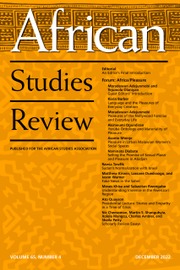Consisting of forty-two essays composed by thirty-eight different contributors spanning the fields of anthropology, classics, film, history, medieval studies, religious studies, sociology, and theology, The Palgrave Handbook of Christianity in Africa from Apostolic Times to the Present, edited by Andrew Eugene Barnes and Toyin Falola, offers a timely and comprehensive account of the historical development of Christianity on the African continent. As a volume that seeks “to supply both a compressive introduction to the study of the Christian faith as it has been practiced on the continent in the past and a summary understanding of the findings of the most current historical investigations of Africa’s Christian past,” the work masterfully succeeds in cataloging knowledge of Christianity on the African continent for succeeding generations (1).
Divided into four parts, Part One of this impressive tome honors the legacies, and examines the ongoing influences, of ten key nineteenth- and twentieth-century figures who have shaped the study of Christianity in Africa (Chapters Two–Eleven). Although much of the contributions in this section focuses on biographical historiography, the essays here also explore key theological contributions to the proactive doing, and not only the retroactive understanding, of African Christian theology. Moses Moore’s essay on Edward Wilmot Blyden, for instance, discusses his pioneering appropriation of the historical-critical method of biblical exegesis for the African context, while Kevin Ward’s article on Adrian Christopher Hastings scrutinizes the need for international institutional ecclesiological reform in the face of burgeoning local evangelism on the continent.
Following these ten biographical surveys, Part Two of this edited collection turns to the influence of missions, and transatlantic forms of Christianity in Europe and North America, on the development of Christianity in Africa (Chapters Twelve–Twenty-four). Here, topics such as abolitionism, Ethiopianism, interreligious dialogue with Muslims and African Traditional Religion(s), settler-colonialism, and the role of women, for example, are explored from the vantage point of Catholic, mainline Protestant, and Evangelical missions and missionaries in the pluriformity of their varied expressions. As Barnes rightly states in his introductory remarks: “What these chapters show is how the varieties of Christian missions that arrived in Africa from across the Atlantic transcended the obstacle of their origins in the European world to offer to African peoples avenues into fellowship with Christ” (13).
Having provided an overview of the historical antecedents to many contemporary forms of African Christian expression, Part Three of this volume turns to what the editors’ call the “rooting” of Christianity in Africa, focusing on patristic times up to the era of independence (Chapters Twenty-five–Thirty-three). Here, the historical transatlantic forms of Christianity in Europe and North America discussed in Part Two are bracketed and emphasis is placed on indigenous developments in the expression of Christianity in African and African Christian agency as they pertain to topics such as internationalism, revivalism, and witchcraft, among other matters. Eric Fournier and Mark Lewis Tizzoni’s essay on Christian communities in Roman Africa, for example, rejects the old colonialist paradigm of “Romanization” in the hopes of reuniting seminal figures in the Christian tradition–like Augustine, Cyprian, and Tertullian–with their African communities, thereby reminding scholars of the importance of Roman Africa in the global history of Christianity. Similarly, Ethan R. Sanders’s contribution on Ethiopianism in Africa importantly sheds light on the creative ways in which African Christians like Mojola Agbebi, Mangena Maake Mokone, and James Emman Kwegyir Aggrey indigenized their received Euro-North American Christianities.
After exploring this “rooting” from a historical perspective, such an understanding is then applied to the contemporary in Part Four of this collection of essays (Chapters Thirty-four–Forty-two). In doing so, contributions in this section give emphasis to the ways in which modern developments have shaped, continue to shape, and will shape the Christian experience on the continent moving forward. Issues including decolonialism, post-independence, the rise of Pentecostalism, reverse missions, and the promulgation of North Atlantic African diaspora communities are treated with particular attention in these essays, especially as they enlighten paths for future scholarly investigations.
Although the breadth and scope of The Palgrave Handbook of Christianity in Africa is extraordinary, because of its historiographical focus, a few lacunae nonetheless remain. These include theological contributions that: (1) give attention to vibrant Global South-South connections existing between Christianity in Africa and Christianity in Asia (pre-independence) and Latin America (postindependence); (2) consider the relationship between so-called “African” and “Black” theologies (or Christian theologies north and south of the Limpopo River); and (3) focus on the significance of theological documents produced during sociopolitical upheaval (e.g., the 1985 South African Kairos Document). As such, a keen reader might wonder: What are the prospects for Christian theology in Africa moving forward considering the profound historical framing that this collection of curated essays instantiates?
Although such a question goes unaddressed head-on, The Palgrave Handbook of Christianity in Africa nevertheless proves to be a rich scholarly resource, providing a firm historical telling of the evolution of Christianity in Africa from the first centuries of its proliferation on the continent up to the present moment. Truly, it saturates its readers with indispensable knowledge of the evolution of the Christian tradition on the African continent, providing critical—and fundamentally important—understandings for future generations of Christians, scholars, and students.

